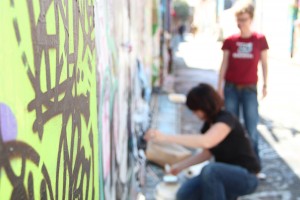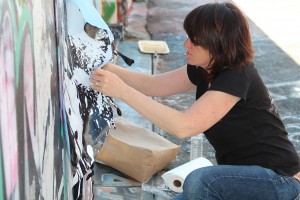Street Arts
____________________________________________________________________
 JK: No … But I fell in love with this material. I put my visual in the city and the city became the frame or continuity.
JK: No … But I fell in love with this material. I put my visual in the city and the city became the frame or continuity.
JK: In total, I have two pieces [on the street], plus there are two pieces in a gallery at Alley Cat … “Orestes” [based on a painting of the mythical figure by William-Adolphe Bouguereau] and then “Calliope,” based on the Greek goddess of art.
- Fluxmagazine.com
http://www.fluxmagazine.com/artist-yola/Peace from the street up – Interview with street artist YOLA October 12, 2015 Art, art featured, Books, Books featured, Culture, Culture featured words Mia KriklerA piece of...
- Hungertv.com
Art & CultureART4PEACE: YOLAPublished on 21 September 2015Post article on TumblrEmail to a friendShareBased between Paris and London and with a background in SFX design, YOLA is one of 21 international urban and street artists who have donated...
- Yola At Alley Cat San Fran
work in progress !! first opportunity to see YOLA's work in San Francisco Opening Friday the 7th September 7-9 PM at Alley Cat 3036 24th street pop in for a drink Guys !! ;-)) YOLA A street name of a Polish street artist Jola Kudela. She...
- Vicious Circle Buenos Aires
One city. A handful of friends. Many different nationalities. One common aim - Vicious Circle in Buenos Aires. The meaning of the original painting “Vicious Circle” by a Polish Symbolist painter Jacek Malczewski,...
- Umierajacy Chrystus - Brzeska
Based on the painting by Andrea Mantegna Lamentation of Christ. The original it’s a religious piece, quoted in all the art-books as the best example of introducing perspective in painting. Here it has a new meaning, It talks about the ethnic appropriation...
Street Arts
missionlocal.org
____________________________________________________________________
Polish-born, London-based Jola Kudela has serious street cred — quite literally.
A digital effects and animation specialist is also part-time traveling paste-up artist. Paste-up is the art of pasting, or gluing, symbolically altered images.
She goes by street name YOLA, and has traveled across the globe seeking bare walls and alluring alleyways — and at times, less than legal venues — to showcase her work.
Her newest canvas? The Mission, where Kudela is absorbing the historic street culture while leaving a contemporary mark of her own.
Missionites can view samples of her work at Alley Cat Books, 3036 24th St., tonight at 7 p.m. In the meantime, here’s what she has to say about her art, the Mission and the world.
Mission Local: You are a professional artist by trade; why did you pick up street art?
Jola Kudela: There was a gallery in Paris that I wanted to approach. I sent them emails and postcards and they never answered me. I said, “Dammit … you don’t want to answer me, I will oblige you to see my work.” So I just painted on a huge [space] and pasted [it] in front of the gallery.
ML: So did they approach you for a job?
 JK: No … But I fell in love with this material. I put my visual in the city and the city became the frame or continuity.
JK: No … But I fell in love with this material. I put my visual in the city and the city became the frame or continuity.Before I used to just do pictures. But I just changed the way of showing them … when you go to the street, it’s huge and you can go much bigger with your work and with a much larger public.
ML: Describe the materials used and the overall process of pasting.
JK: Find the painting that you love … look for [models] who are strong, have some power in them … then do the shoot. I use a green screen and I shoot every person separately.
I can do exactly the same poses like in the painting, or I can try to just cover the main composition of the painting and not really bother about the details. After that, I do work on Photoshop; I try to mix the original painting to … help the viewer, to give him the idea that he has to look for the connections and the symbols.
Then it goes to the printer, you get big huge prints at a commercial printer and they print on blue-back paper. I cut (the printed strips) because I think it doesn’t mix with the environment. When it is cut, it comes together – one whole piece with the surroundings.
ML: How long does the entire process, from research to paste, take?
JK: It can be quite fast or quite long. For example, a project in Paris with 32 people … took me five weeks. But a piece in Melbourne I made in one hour of shooting and four hours of work.
ML: There are often legal limits on public property. How do you work around them?
JK: When you do it illegally, you do it in silence. [When we are traveling], we try not to get into trouble. We try to learn first what we can do and where. But when I am home in Poland, I’m going much farther. [One of my pieces] in Warsaw is in the middle of the street. I hired a cherry picker [a truck with a rising platform] in the middle of the night and two guys … We weren’t stopped.

The same night, we went to do another small piece and we were caught by the police. This was one month ago. [She paid a fine, which she claims was illegal, and had to restore the bridge.]
ML: You travel around the world. Why the Mission?
JK: It seems to be the center of street art and a very vibrant community … this is my favorite part of the city.
[Mission artist and author of the book “Mission Muralismo”] Annice Jacoby has been very helpful, and she’s given us a lot of suggestions and a lot of help with getting in touch with people. She’s a really wonderful curator of street art.
ML: Talk a bit about the paste-up pieces specifically in the Mission.
JK: In total, I have two pieces [on the street], plus there are two pieces in a gallery at Alley Cat … “Orestes” [based on a painting of the mythical figure by William-Adolphe Bouguereau] and then “Calliope,” based on the Greek goddess of art.
Every visual has a sense, has a meaning … [The piece on Clarion Alley] is called “Corporate Jesus.” Instead of being crucified on a cross, [the model] is being crucified on a dollar sign. He’s like an ordinary guy running around in the city. He sold his soul to his religion, which is money.
ML: The question asked of every artist: what is your inspiration?
JK: What I'm trying to do is play with the meaning. You tweak the original painting, the original meaning or the original story. You change the models and you transform the story and you adapt it to our world. Most of the subject is tolerance for the differences the people can have. That society is not homogenous. There isn’t anything called normality because everyone is different.
ML: What is your favorite — or the most interesting — location for pasting?
JK: Apart from being in the Mission, my favorite street art cities are Melbourne, Australia, and Buenos Aires, Argentina.
Both of these cities are very open, and helpful people … and you feel like a part of a kind of movement … You are part of something bigger.
[In the Mission] I found really that when we approach people … they’re quite open and helpful. It’s quite unusual.
It’s so far from my culture. it’s a completely different visual that I really didn’t know before.
For more on the artist click here.
- Fluxmagazine.com
http://www.fluxmagazine.com/artist-yola/Peace from the street up – Interview with street artist YOLA October 12, 2015 Art, art featured, Books, Books featured, Culture, Culture featured words Mia KriklerA piece of...
- Hungertv.com
Art & CultureART4PEACE: YOLAPublished on 21 September 2015Post article on TumblrEmail to a friendShareBased between Paris and London and with a background in SFX design, YOLA is one of 21 international urban and street artists who have donated...
- Yola At Alley Cat San Fran
work in progress !! first opportunity to see YOLA's work in San Francisco Opening Friday the 7th September 7-9 PM at Alley Cat 3036 24th street pop in for a drink Guys !! ;-)) YOLA A street name of a Polish street artist Jola Kudela. She...
- Vicious Circle Buenos Aires
One city. A handful of friends. Many different nationalities. One common aim - Vicious Circle in Buenos Aires. The meaning of the original painting “Vicious Circle” by a Polish Symbolist painter Jacek Malczewski,...
- Umierajacy Chrystus - Brzeska
Based on the painting by Andrea Mantegna Lamentation of Christ. The original it’s a religious piece, quoted in all the art-books as the best example of introducing perspective in painting. Here it has a new meaning, It talks about the ethnic appropriation...
